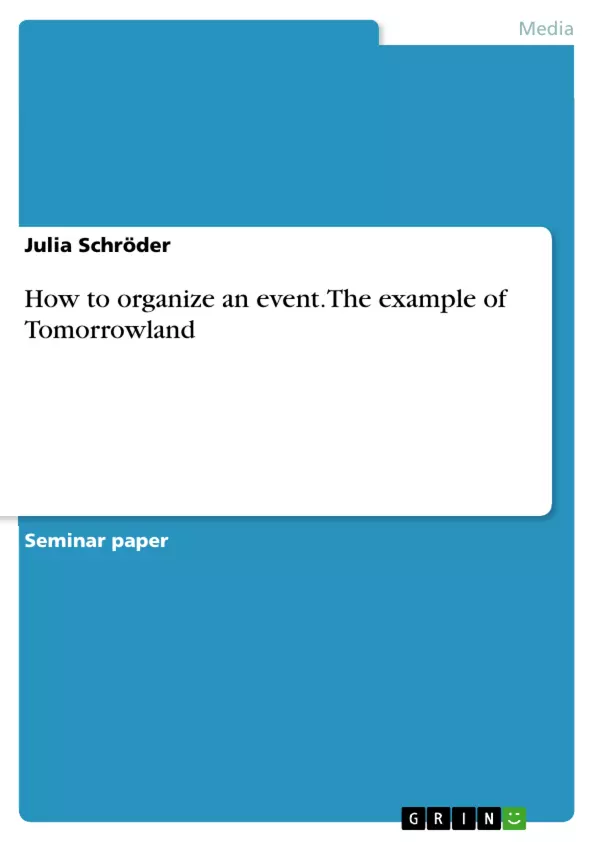This report describes which requirements are placed on successful event management for large events in the music industry, which resources are needed, how the logistics are structured, and which marketing is used for a successful event. Another part of an event is funding. Considerable financial resources are important, especially for large events. Methods of how the Tomorrowland Festival is funded will be presented.
Table of Contents
- 1 Introduction
- 2 Nature of the Tomorrowland Festival
- 2.1 Objective and Venue
- 3 Resources
- 3.1 Staffing
- 3.2 Insurance
- 3.3 Budget and Funding
- 3.3.1 Tickets
- 3.3.2 Sponsors
- 3.3.3 Merchandising
- 3.3.4 Company Sales
- 4 Logistics
- 4.1 Lighting and Staging
- 4.2 Catering
- 4.3 Sound
- 4.4 Amenities
- 4.4.1 Payment Methods
- 4.4.2 Toilet Facilities
- 5 Marketing
- 6 Risk Management
Objectives and Key Themes
The main objective of this report is to describe the requirements for successful event management of large music industry events, focusing on Tomorrowland. It examines resource allocation, logistical structure, marketing strategies, and funding mechanisms. The report aims to illustrate how these elements contribute to the overall success of such a large-scale festival.
- The nature and unique selling points of large-scale EDM festivals.
- Resource management (staffing, budgeting, sponsorship).
- Logistical considerations (lighting, staging, catering, amenities).
- Effective marketing strategies for large music festivals.
- Risk management within the context of large-scale events.
Chapter Summaries
1 Introduction: This introductory chapter establishes the context of the report by highlighting the growing significance of EDM festivals like Tomorrowland in today's multimedia-saturated world. It emphasizes the sense of community fostered by these events and the increasing demands of a sophisticated audience. The chapter also underscores the economic impact of such festivals, touching upon their role in the music industry and corporate communication. Finally, it outlines the report's scope, focusing on successful event management, resource needs, logistics, marketing, and funding mechanisms, specifically within the context of Tomorrowland.
2 Nature of the Tomorrowland Festival: This chapter delves into the unique characteristics of Tomorrowland, contrasting it with other EDM festivals. It highlights ID&T, the organizing company, and its role in establishing Tomorrowland's success. The chapter uses data to showcase Tomorrowland's growth, emphasizing its consistent increase in attendance and its reputation as a globally renowned event. It also discusses the festival's diverse musical offerings, broad appeal, and its unique selling proposition. The chapter establishes Tomorrowland as a benchmark for successful EDM festival organization.
Keywords
Electronic Dance Music (EDM), Tomorrowland Festival, Event Management, Resource Management, Logistics, Marketing, Funding, Risk Management, Unique Selling Point (USP), ID&T, Large-Scale Events, Music Industry.
Tomorrowland Festival Event Management Report: FAQ
What is the purpose of this report?
This report analyzes the successful event management of large music industry events, using Tomorrowland as a case study. It examines resource allocation, logistics, marketing, and funding, illustrating how these elements contribute to the overall success of such a large-scale festival.
What are the key themes explored in the report?
The report explores the nature and unique selling points of large-scale EDM festivals; resource management (staffing, budgeting, sponsorship); logistical considerations (lighting, staging, catering, amenities); effective marketing strategies; and risk management within the context of large-scale events.
What topics are covered in each chapter?
Chapter 1 (Introduction): Sets the context, highlighting the significance of EDM festivals, their economic impact, and the report's scope. Chapter 2 (Nature of the Tomorrowland Festival): Delves into Tomorrowland's unique characteristics, its growth, and its position as a globally renowned event. Further chapters cover resources, logistics, marketing, and risk management.
What resources are discussed in relation to Tomorrowland?
The report discusses staffing, insurance, budget and funding (tickets, sponsors, merchandising, company sales) as key resources required for successful event management.
What logistical aspects are covered in the report?
Logistical aspects covered include lighting and staging, catering, sound, and amenities (payment methods, toilet facilities).
How does the report address marketing and risk management?
The report examines effective marketing strategies for large music festivals and discusses risk management within the context of large-scale events, though specific details are not provided in this preview.
What is the overall objective of the report?
The main objective is to describe the requirements for successful event management of large music industry events, focusing on Tomorrowland as a prime example.
What are the key words associated with this report?
Electronic Dance Music (EDM), Tomorrowland Festival, Event Management, Resource Management, Logistics, Marketing, Funding, Risk Management, Unique Selling Point (USP), ID&T, Large-Scale Events, Music Industry.
What is the target audience for this report?
While not explicitly stated, the academic nature and detailed structure suggest the target audience is likely students or researchers in event management, business, or related fields.
Where can I find more information on the Tomorrowland Festival?
This preview only provides a summary of the report. For detailed information, you would need to access the full report.
- Quote paper
- Julia Schröder (Author), 2020, How to organize an event. The example of Tomorrowland, Munich, GRIN Verlag, https://www.hausarbeiten.de/document/1194408


